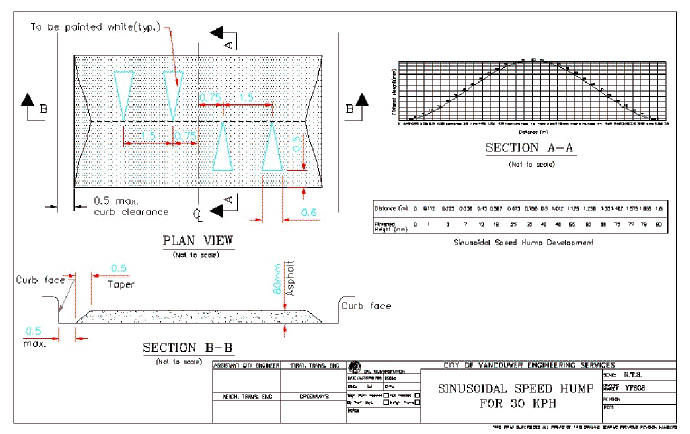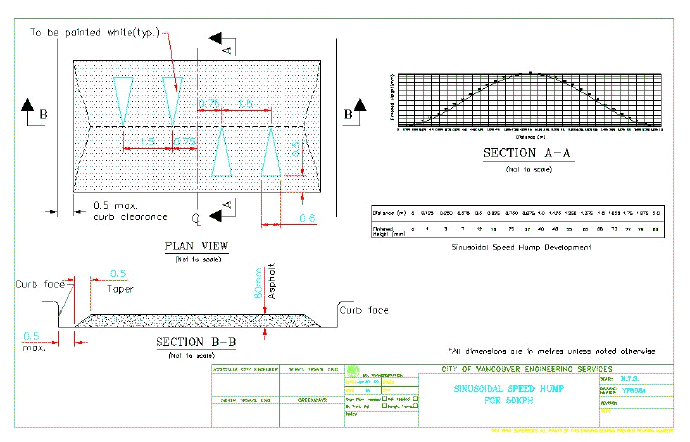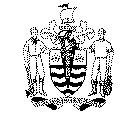
ADMINISTRATIVE REPORT
Date: April 5, 2001
Author/Local:D.Rawsthorne/7343
RTS No. 1782
CC File No.: 5757
T&T: April 24, 2001
TO: |
Standing Committee on Transportation and Traffic |
FROM: |
General Manager of Engineering Services |
SUBJECT: |
Annual Speed Hump Installation Program, 2001 |
RECOMMENDATION
A. THAT speed humps be installed on the local, residential streets specified in this report subject to approval from a resident survey with funding of $250,000 provided from Streets Basic Capital Unappropriated - Local Area Traffic Plans and Other Improvements, subject to approval of the 2001 Streets Basic Capital Budget.
B. THAT commencing in 2002, the Traffic Operating Budget be increased by $3,400, without offset.
POLICY
The City of Vancouver Transportation Plan (1997) directed that the City's traffic calming plan give priority to streets and neighbourhoods where traffic impacts are the most serious.
On November 2, 1999, Council approved an annual speed hump installation program that would identify the highest ranking local, residential street segments for speed hump installation.
PURPOSE
This report seeks approval and funding for the second Annual Speed Hump Installation Program. It identifies the proposed speed humps locations and outlines a method for public consultation.
BACKGROUND
In 1999 the City completed the Speed Hump Pilot Project. The results of the pilot project indicate that speed humps are an effective device for decreasing speeds on local residential streets while not diverting traffic to other streets.
In order to choose the streets to be included in the pilot, an objective scoring calculation was used, adapted from a successful program in Portland, Oregon (see Appendix A). This calculation was then approved by Council in November 1999 and used to identify the priority, or top ranked, streets for speed hump installation in this year's program. The calculation considers the number and speed of vehicles on the block, as well as special attributes such as whether the street is near a pedestrian generator or is part of a greenway or bikeway. The speed measure used is the 85th percentile speed, or the speed below which 85% of vehicles are travelling and above which 15% of vehicles are travelling.
There are two designs used for speed humps on local streets (see Appendix B), one for 30 km/h speed zones and another for 40 km/h speed zones. The latter reflects the City's intention to lower the speed limit on local, residential streets from 50 km/h to 40 km/h. The main difference between the humps is their length, or driving distance, as the 40 km/h hump is designed to be more gradual. The two hump types are also designed to be installed at different intervals along the street, with more frequent humps on lower speed streets. The speed hump calculation allows 30 km/h zones to be compared directly to 40 km/h zones.
DISCUSSION
15 street segments are being recommended for speed hump installation this year. Of these segments, nine are adjacent to parks, ten are in school zones and five are on bike routes. All but one segment, West 37th Avenue between Hudson and Cartier, are in 30 km/h zones. The following is a list of the street segments with information about their ranking and the approximate number of humps to be installed:
|
Street Segment |
Score |
85th Percentile Speed
|
Design Speed (km/h) |
Estimated Traffic Volume
|
Estimated Number of Speed Humps |
West 8th Ave,
|
172 |
56 |
30 |
4700 |
13 |
Slocan St,
|
170 |
63 |
30 |
1800 |
3 |
Muirfield Dr,
|
147 |
65 |
30 |
1100 |
6 |
East Pender St,
|
143 |
61 |
30 |
900 |
4 |
East Kent St. South,
|
133 |
65 |
30 |
300 |
6 |
Heather St,
|
126 |
52 |
30 |
3200 |
8 |
Ross St,
|
122 |
58 |
30 |
1200 |
7 |
West 39th Ave,
|
121 |
54 |
30 |
1400 |
3 |
Adanac St,
|
121 |
52 |
30 |
900 |
2 |
Yew St,
|
120 |
56 |
30 |
700 |
8 |
East 14th Ave,
|
120 |
52 |
30 |
1000 |
5 |
West 37th Ave,
|
119 |
64 |
40 |
800 |
2 |
Ash St,
|
115 |
56 |
30 |
1700 |
4 |
Nanaimo St,
|
113 |
51 |
30 |
1700 |
5 |
Crown St,
|
110 |
49 |
30 |
2600 |
8 |
One of the street segments, Muirfield Drive, between Hoylake and Scarboro, is on a transit route. Staff are consulting with Translink to ensure that the speed humps installed do not unduly restrict bus efficiency or passenger safety.
Four street segments which rank among the proposed speed hump locations are not included in this proposal. The traffic calming warranted in these locations is being addressed by other neighborhood traffic calming or Greenways programs.
Evidence suggests that speed humps will not cause significant diversion of traffic on to adjacent streets. However, staff recommend that volumes be monitored before and after these installations and that they report back prior to future installations.
CONSULTATION
Resident consultation and subsequent approval is an important part of the Speed Hump program. Staff propose that all residents living on the same street segments as the proposed speed humps be surveyed for their opinions. The surveys would ask two questions (see Appendix C for an example) about whether the residents feel that there is a speeding problem on their street and whether they approve of speed humps. Installation of speed humps on each street segment will be subject to a survey response rate greater than 30% and an approval rate greater than 50%. Staff recommended that speed humps be installed on all of the proposed streets that meet these criteria and that staff report back on any locations that do not for further consideration.
FINANCIAL IMPLICATIONS
The estimated capital cost of installing speed humps, as specified in this report, is $250,000 for the 15 proposed locations. Included in this cost is construction of the asphalt humps, paint markings, warning signs, traffic monitoring and public consultation. Funding for this project is available from Streets Basic Capital Unappropriated - Local Area Traffic Plans and Other Improvements, subject to approval of the 2001 Streets Basic Capital Budget.
In addition to the capital costs for this project there will be maintenance costs associated with the signing and paint marking of the speed humps. Staff recommend that the Traffic Operating Budget be increased by $3,400.
CONCLUSION
Speed humps are an effective means by which to slow vehicles on local streets and the locations identified in this report are the highest ranking, highest priority locations, in accordance with the ranking system approved by Council in November 1999. Staff recommend that speed humps be installed in 15 high ranking locations, subject to resident approval. Staff will report back on any locations that are not approved by the survey and will monitor traffic volumes before and after the humps are installed.
* * * * *
APPENDIX A - SPEED HUMP SAMPLE SCORE CALCULATION
Vanness Avenue 3400 block
Raw Data
Sample size = 98 vehicle speeds
Average Daily Traffic (ADT) volume = 3000 ADT
85th percentile speed (calculated) = 52.2 km/h
Design speed limit = 40 km/h
Description Points
Primary Score
Speed Points:
Assign 3 points for each km/h in excess of 8 km/h over the design speed
(max. 50 points) (52.2 - (40 + 8)) x 3 = 12
Volume Points (ADT/100 = 3000/100) = 30
Subtotal = 42
Is the Primary Score greater than 40?
|
Secondary Score
Additional Speed Points for excessive speed (based on percentage of
vehicles travelling over 16 km/h beyond the design speed of the hump
i.e. percent travelling>40 + 16 km/h = 56km/h) : 8% = 8
Score 5 points for each school zone (maximum 10) 0
Score 5 points for each pedestrian generator (maximum 15) 10
Count SkyTrain Station/bus loop and retail area as two ped generators
Score 5 points if adjacent to a Greenway (is part of the BC Parkway) 5
Score 5 points if the street segment is part of a Bikeway 5
Score 5 points if the street segment lacks a continuous sidewalk 5
Subtotal = 33
TOTAL SCORE (Primary + Secondary) = 75
APPENDIX B - SPEED HUMP DESIGNS


APPENDIX C - SAMPLE RESIDENT SURVEY
 City of Vancouver Survey
City of Vancouver Survey
Speed Hump Program
City of Vancouver May 2001
Dear Resident:
This survey seeks your opinion of vehicle speed on your street and whether or not you approve of the installation of speed humps.
Speed humps are proven as an effective means by which to decrease vehicle speeds on local, residential streets. In response to a neighbourhood complaint about speeds on your street, the City has taken field measurements and confirmed that vehicle speeds are high on your street and that your street is a good candidate for speed humps. City Council has therefore approved speed humps for your street, subject to your approval.
At least 30% of the residences on your street must respond to this survey and 50% of the responses must support the installation of speed humps. Should you approve speed humps, you can expect them to be placed 50-70 m (160-230 ft) apart. They should not affect parking. A typical design showing the dimensions of the humps is shown on the reverse side of this letter, for your information.
The Speed Hump Program is funded by the City of Vancouver's capital budget and will not increase your taxes.
Please give this survey your consideration and return it in the addressed, postage paid envelope provided by May 31, 2001. Alternatively, you may fax the completed survey to 871-6192. Your name and address must be included on the survey in order to validate your response; however, individual replies will be kept confidential.
The results of this survey will determine whether speed humps will be installed on your street. If you have any questions about speed humps in general, or how they will be installed on your street, please call me at 873-7343 or e-mail me at [email protected].
Yours truly,
David Rawsthorne, P.Eng.
Neighbourhood Transportation Branch
DR/
* * * * *